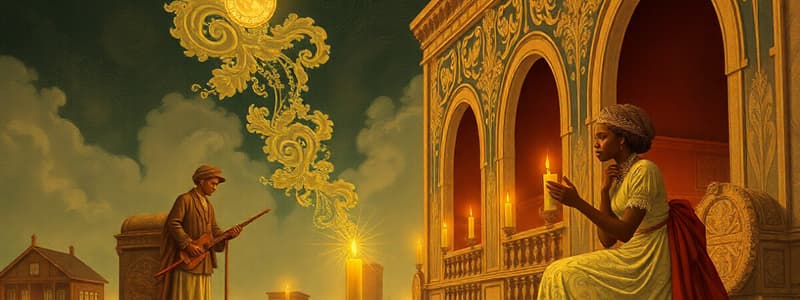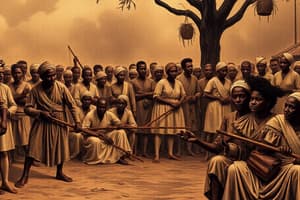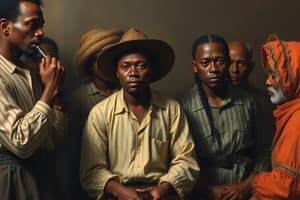Podcast
Questions and Answers
How did Britain's actions following the American Revolution impact the economic landscape for enslavers in the United States?
How did Britain's actions following the American Revolution impact the economic landscape for enslavers in the United States?
- By providing new markets for American tobacco and rice, increasing the profitability of slave labor.
- By implementing tariffs on goods produced using enslaved labor, making American goods more competitive.
- By directly funding the expansion of plantations in the newly independent states.
- By closing West Indian markets to Chesapeake tobacco and Carolina rice, which resulted in an oversupply of enslaved labor and economic losses for enslavers. (correct)
What distinguished Vermont's approach to slavery compared to other states in the post-Revolutionary period?
What distinguished Vermont's approach to slavery compared to other states in the post-Revolutionary period?
- Vermont implemented a gradual abolition plan, similar to other New England states.
- Vermont compensated enslavers for the loss of their 'property' upon abolition.
- Vermont was the only state to immediately outlaw slavery, owing to its small enslaved population. (correct)
- Vermont heavily relied on enslaved labor, thus avoiding taking any action to abolish slavery.
How did the economic interests of states influence their decisions regarding slavery in the years following the American Revolution?
How did the economic interests of states influence their decisions regarding slavery in the years following the American Revolution?
- All states uniformly prioritized the abolition of slavery, regardless of their economic systems.
- States with minimal economic reliance on slavery avoided implementing abolition, fearing economic disruption.
- States heavily reliant on slave labor quickly moved towards complete abolition to modernize their economies.
- States dependent on slave labor resisted abolition, while those with marginal slave populations initiated gradual abolition processes. (correct)
What was the significance of cases like Walker v. Jennison in Massachusetts regarding the abolition of slavery?
What was the significance of cases like Walker v. Jennison in Massachusetts regarding the abolition of slavery?
What impact did the invention and rising prominence of cotton have on slavery in the United States?
What impact did the invention and rising prominence of cotton have on slavery in the United States?
How did the U.S. Constitution address or fail to address the issue of slavery, and what were the implications of these decisions?
How did the U.S. Constitution address or fail to address the issue of slavery, and what were the implications of these decisions?
What role did the American Colonization Society play in the discussion about slavery?
What role did the American Colonization Society play in the discussion about slavery?
What factors contributed to the weakening of the tobacco and rice economies in the post-Revolutionary War period?
What factors contributed to the weakening of the tobacco and rice economies in the post-Revolutionary War period?
How did the Northwest Ordinance of 1787 address the issue of slavery in the Northwest Territory, and what was its significance?
How did the Northwest Ordinance of 1787 address the issue of slavery in the Northwest Territory, and what was its significance?
How did Thomas Jefferson's views expressed in 'Notes on the State of Virginia' influence the discourse on slavery and race in the early American republic?
How did Thomas Jefferson's views expressed in 'Notes on the State of Virginia' influence the discourse on slavery and race in the early American republic?
Flashcards
Economic Impact of British Trade Restrictions
Economic Impact of British Trade Restrictions
Post-revolution, Britain penalized the US economy by restricting access to West Indian markets for Chesapeake tobacco and Carolina rice, intensifying strain on slave labor.
Post-Revolution Abolition
Post-Revolution Abolition
Following the American Revolution, states with few slaves began gradual abolition, but freedom did not guarantee citizenship; Vermont was the first state to outlaw slavery immediately.
Resumption of Captive Importation
Resumption of Captive Importation
Despite the closure of rice markets South Carolina and Georgia planters began importing captive Africans, increasing the demand for bondspersons.
Constitutional Approach to Slavery
Constitutional Approach to Slavery
Signup and view all the flashcards
Compromises in the Constitution on Slavery
Compromises in the Constitution on Slavery
Signup and view all the flashcards
Federal Restriction of Slavery's Expansion
Federal Restriction of Slavery's Expansion
Signup and view all the flashcards
Complex Transition of Slavery after Independence
Complex Transition of Slavery after Independence
Signup and view all the flashcards
Slavery's Expansion with Cotton
Slavery's Expansion with Cotton
Signup and view all the flashcards
The Revolution's racial legacy
The Revolution's racial legacy
Signup and view all the flashcards
Slavery Economies Transform
Slavery Economies Transform
Signup and view all the flashcards
Study Notes
Slow Death for Slavery?
- After the United States gained independence, slavery appeared to be headed toward decline.
- Britain's closure of West Indian markets to Chesapeake tobacco and Carolina rice caused economic challenges for enslavers.
- Enslaved people faced the struggle between establishing roots and the constant disruptions caused by enslavers.
- Patriots were hesitant to immediately free enslaved people.
- The slave societies in the Chesapeake, Carolinas, and Georgia were patched up, while enslavers in the Mid-Atlantic reasserted their control.
- Republican principles of liberty and self-government were not fully applied to enslaved people due to the economic significance of slavery.
- States with small slave populations began to gradually abolish slavery after 1776, but freedom did not guarantee citizenship.
- Vermont, with the smallest slave population, immediately outlawed slavery.
- New England, New York, Pennsylvania, and New Jersey chose gradual abolition methods or allowed enslaved people to challenge enslavement in courts.
- States that relied on slave labor did not consider abolishing it.
- Manumission, or the individual freeing of enslaved people, was permitted in some states.
- Virginia, Maryland, and other Southern states (excluding North Carolina) eased manumission laws.
- Laws still prioritized property rights, and only a few enslaved people were able to negotiate their way out of bondage.
Despite British Market Closures
- South Carolina and Georgia planters continued to import enslaved Africans.
- Chesapeake enslavers began to sell enslaved people in an interstate trade.
- Enslavers in states where slavery was marginal still held onto enslaved people who had market value.
Northern States and Gradual Abolition
- States north of Delaware gradually abolished slavery, but a history of associating African descent with servitude hindered full equality.
- This perception negatively impacted free African-descended people.
- Former patrons were replaced by wage and labor markets that offered little opportunity for workers to improve their circumstances.
- The new United States was a fragile confederation of independent states.
- States formulated individual laws regarding slavery, similar to their colonial predecessors.
- Between 1777 and 1804, all states north of Maryland implemented measures to gradually abolish slavery.
Revolutionary War and State Constitutions
- During the war, state governments created new constitutions, experimenting with republican government.
- Black activists, like Lemuel Haynes and Felix Holbrook, and their appeals for abolition resonated with the language of liberties and rights.
- State legislators attempted to incorporate abolition measures into law, driven by the ideals of the Revolution.
- Appeals to abandon slavery were more successful in areas where slavery remained limited.
- Measures concerning slavery were often compromised due to competing interests.
- Vermont's 1777 constitution abolished slavery and servitude for males over twenty-one and females over eighteen.
- The constitution also established religious liberty and enfranchisement for nearly all adult males, regardless of race or previous condition of servitude.
- Colorblind measures were uncontroversial due to Vermont’s small number of enslavers and Black people in the state.
New Hampshire and Massachusetts
- In 1790, Vermont was 0.3 percent nonwhite, not counting Native Americans.
- New Hampshire's 1783 constitution contained strong language on individual rights, but slavery was not clearly defined.
- The slave population decreased from 633 to 158 people between 1767 and 1790 and would be counted in single digits during the nineteenth century.
- Massachusetts adopted similar language and the state was the first in the area to construct abolition law.
- Article 1 of the 1780 Massachusetts constitution stated that all men are born free and equal.
- The challenge to slavery in Massachusetts began with Quok Walker, a former slave.
- Walker fled his owner's farm in 1781 and sought a legal remedy for assault, not his freedom.
- Walker argued that the court should uphold the republican principles for which Massachusetts Patriots were fighting.
- The case, Walker v. Jennison, resulted in the Supreme Judicial Court's 1783 ruling that slavery is inconsistent with the constitution.
- Favorable rulings by lower courts had already freed Mum Bett, who became known as Elizabeth Freeman.
- Women, even in freedom, and Black women, like Elizabeth Freeman, were doubly disenfranchised.
Unrequited Toil
- The Walker decision didn’t free any new slaves in Massachusetts, however decided that Massachusetts law couldn’t protect slave property.
- Slave owners tried to get around decisions.
- New York made a false start in abolishing slavery.
- Fugitives were fleeing from Virginia and elsewhere.
Legal Ambiguity and the Constitution
- The 1777 constitution protected slave property.
- Made it possible for freeholders to vote .
- Military service was one path to receiving freedom.
- The government would manumit slaves who served.
- New York's Manumission Society.
- Made sure known supporters for the Crown were stripped of their positions.
- New York's Federal was 21,324 slaves in 1790.
- Did not pass a measure until 1799.
- Pennsylvania struggled with human liberty versus property rights in its 1780 constitution.
- Philadelphia would be the largest American city.
- Quakers were big opponents of slavery.
- Petitioned the government to live up to restoration.
- 3% of the people in that area were black.
Petitions and Quaker Activity
- Pennsylvania passed an abolition act that failed to free any slaves.
- All enslaved children still remained enslaved.
- Possibility for owners to keep slaves for 2 more generations.
- Ended up abolishing slavery in 1847.
- Enslaved women got out of out of state babies to be born.
- New England took their advice from Philadelphia.
Rhode Island and Gradual Abolition
- The Society of Friends advocated for black freedom. Rhode Island passes this abolition law.
- Shippers and merchants remained active during this trade.
- Continues to embark slaves for decades more.
- Fewer than 400 enslaved were counted.
- Other free states are reluctant to give up citizen property.
- 1784 abolished the people in slavery.
- Life expectancy was thought to be the age of 30.
- Even enslaved people’s property rights was an impediment to the people's independence.
- A widespread expectation would be confined to a narrow patch of land.
Attempts to regulate and expand slavery
- Ambivalent attempts
- Congress in the Article of Confederation prohibited slavery.
- The Northwest Ordinance of 1787 abolished slavery.
- Restricted black residents posting bonds.
- The first US congress responded to pressure.
- Passed The Southwest Ordinance in 1790
- Federal authority promised to remove Indian nations.
- Even before the rise of cotton, the government promoted slavery expansion.
Emergence Of Racism
- Developed the European idea of white exceptionalsim.
- Carl Linnaeus classified human beings.
- Divided into subspecies.
- Stated black peole were "crafty, indolent, and negligent."
- The notes by Virginia Thomas Jefferson argued about the rights of African American citizens.
- Jefferson contemplated a gradual freeing of female from eighteen and makes to twenty-one.
- Believed Black’s were more sexually aggressive.
- Had memories that were equal.
- Intellectual lack.
- Did no let them excuse their agricultural behavior.
Revolutionary War Impact
- Ambivalent Virginia and Maryland passed laws.
- Religious conviction.
- Removed the right and property in the persons of any of his fellow creatures.
- Provided without back wages or health care.
- Blacked increased toward freedom.
- North of the lines they passed to gradual emancipation.
- Slaves were granted freedom in order to favor laws of Virginia.
The Washingtons
- George Washington favored the laws.
- Washington directed his slaves to be freed after Martha Washington died.
- Some people Washington were sold.
- Martha attempted to reach for money.
- Bushrod a US Supreme Court also for emigration.
- Did not pay estates or debts.
- Federal conversation was to protect slavery and limits on political power.
Political Weakness And Debate
- Old slave economies were threatened by the Revolution.
- Was unclear in North America.
- There were delegates at the 1787.
- Protected slavery but limited the political legislature.
- 1808 banned from foreign import covers.
- States has slowly restricted political evils.
- Wilson, in 1787 wanted to eradicate slavery in the state.
The rise of Cotton
- The rise of slaves were key for America
- George Washington noted in 1789 with his own notes
Trade Routes
- There are several ships and their trading routes.
- People were transported from state to state.
- They were being sold and transported against their own will.
Unrequited toil
- By the end the British revolution banned.
- Sold Africans in Charleston
- US passed an act banning the trade.
- Several deaths were accounted.
- Survivors were treated with great care
- The survivors were sold.
Culimnation of revolution
- Developed grammar of political freedom.
- But patriots had to fight.
- Fought british-allied Indians ad African decedents.
- Disqualification predicted on perceiving inferiority.
- Became a forgotten aspect.
- Economic changes reshaped the US.
Studying That Suits You
Use AI to generate personalized quizzes and flashcards to suit your learning preferences.




